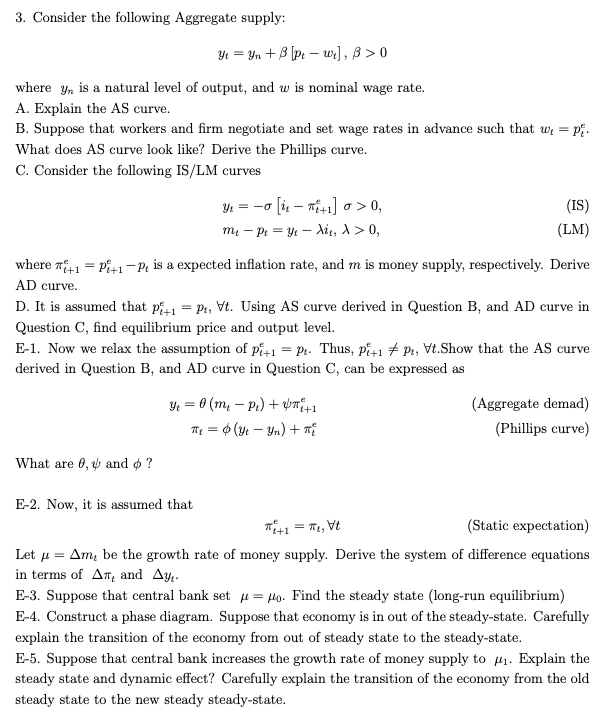
3. Consider the following Aggregate supply: yt=yn+[ptwt],>0 where yn is a natural level of output, and w is nominal wage rate. A. Explain the AS curve. B. Suppose that workers and firm negotiate and set wage rates in advance such that wt=pte. What does AS curve look like? Derive the Phillips curve. C. Consider the following IS/LM curves yt=[itt+1e]>0,mtpt=ytit,>0, where t+1e=pt+1ept is a expected inflation rate, and m is money supply, respectively. Derive AD curve. D. It is assumed that pt+1e=pt,t. Using AS curve derived in Question B, and AD curve in Question C, find equilibrium price and output level. E-1. Now we relax the assumption of pt+1e=pt. Thus, pt+1e=pt,t.Show that the AS curve derived in Question B, and AD curve in Question C, can be expressed as yt=(mtpt)+t+1et=(ytyn)+te (Aggregate demad) (Phillips curve) What are , and ? E-2. Now, it is assumed that t+1e=t,t (Static expectation) Let =mt be the growth rate of money supply. Derive the system of difference equations in terms of t and yt. E-3. Suppose that central bank set =0. Find the steady state (long-run equilibrium) E-4. Construct a phase diagram. Suppose that economy is in out of the steady-state. Carefully explain the transition of the economy from out of steady state to the steady-state. E-5. Suppose that central bank increases the growth rate of money supply to 1. Explain the steady state and dynamic effect? Carefully explain the transition of the economy from the old steady state to the new steady steady-state. 3. Consider the following Aggregate supply: yt=yn+[ptwt],>0 where yn is a natural level of output, and w is nominal wage rate. A. Explain the AS curve. B. Suppose that workers and firm negotiate and set wage rates in advance such that wt=pte. What does AS curve look like? Derive the Phillips curve. C. Consider the following IS/LM curves yt=[itt+1e]>0,mtpt=ytit,>0, where t+1e=pt+1ept is a expected inflation rate, and m is money supply, respectively. Derive AD curve. D. It is assumed that pt+1e=pt,t. Using AS curve derived in Question B, and AD curve in Question C, find equilibrium price and output level. E-1. Now we relax the assumption of pt+1e=pt. Thus, pt+1e=pt,t.Show that the AS curve derived in Question B, and AD curve in Question C, can be expressed as yt=(mtpt)+t+1et=(ytyn)+te (Aggregate demad) (Phillips curve) What are , and ? E-2. Now, it is assumed that t+1e=t,t (Static expectation) Let =mt be the growth rate of money supply. Derive the system of difference equations in terms of t and yt. E-3. Suppose that central bank set =0. Find the steady state (long-run equilibrium) E-4. Construct a phase diagram. Suppose that economy is in out of the steady-state. Carefully explain the transition of the economy from out of steady state to the steady-state. E-5. Suppose that central bank increases the growth rate of money supply to 1. Explain the steady state and dynamic effect? Carefully explain the transition of the economy from the old steady state to the new steady steady-state







